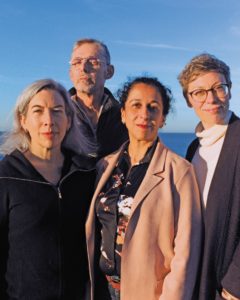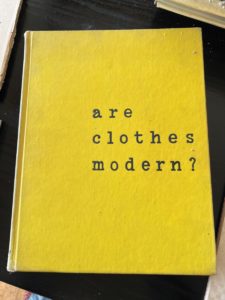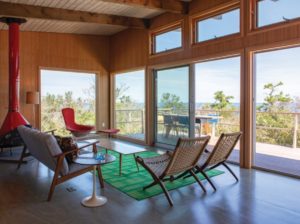WELLFLEET — There was treasure hidden deep within the pitch pine woods of Wellfleet — and, according to Elizabeth Otto, one of four scholars who participated in a residency overseen by the Cape Cod Modern House Trust last month, “finding it was slightly haunting and very amazing.”

The treasures came from the library and art collection of Hungarian architect and designer Marcel Breuer (1902-1981), which had been preserved by CCMHT founder Peter McMahon with the help of Breuer’s son, Tamas. They were relics of an era of artistic experimentation and innovation brought over from Europe by members of the Bauhaus, the pre-World War II German art school known for its avant-garde pedagogy and artistic practice. Several of the most illustrious members of the group designed summer houses for themselves and their friends on the Outer Cape.
Otto was the curator of this year’s residency through CCMHT, which annually invites a group of artists and thinkers to stay in the modernist houses in Wellfleet that it has restored. The Bauhaus residency was originally planned for 2019 for the centennial of the Bauhaus school, founded in Weimar, Germany by architect Walter Gropius in 1919, but a series of setbacks, including the pandemic, pushed the residency to 2022.
Otto, a professor of modern and contemporary art history at SUNY Buffalo, invited three other Bauhaus scholars to participate: Oliver Botar, professor of art history at the University of Manitoba in Winnipeg; Veronika Fuechtner, interim chair of Jewish studies and associate professor of German studies at Dartmouth College; and Jordan Troeller, a postdoctoral researcher at the Freie Universität Berlin.
When the scholars finally arrived in Wellfleet, they were not disappointed. The trust’s houses were filled with books and printed ephemera — most of which had never been seen by outsiders before — from the artists’ lives on the Cape more than 70 years ago.
“They were here partly to see this material, which has never been archived,” McMahon said.
Hidden in the collection were journals, Christmas and birthday cards, paintings, and poems by Bauhaus writers and artists, as well as books with inscriptions written from one Bauhausler to another.
“It took us a while to just calm down because it was so exciting,” Otto said. “To be in those spaces with the material was so special. There was definitely some positive haunting.”
Among the more interesting discoveries the scholars made in Breuer’s library was a 1947 book called Are Clothes Modern?, an exciting find for Otto and Fuechtner, who are working on a joint project about nudism in the Bauhaus.

“Neither of us had seen it before,” said Otto, “and it helped us think of the other side of this question of what they were wearing and why they were taking off their clothes.”
Nudism was a pillar of Bauhaus tradition. The German school was evicted from its first building after students were caught bathing naked in Berlin’s Goethe Park. The Bauhauslers who vacationed on the Cape were known to swim, sunbathe, and walk naked along Newcomb Hollow Beach — much to the chagrin of local families and their children, who were “about crotch height with all these beaching Europeans,” Otto said.
Otto also found three books in the Breuer collection that belonged to Marta Erps, Breuer’s first wife. Though Erps was also a member of the Bauhaus, “she always seemed to have gotten rubbed out of the picture,” Otto said. “To find some trace of her history and what she was interested in was magical.”
Botar, the art history professor, found poems written by Breuer’s friend and fellow architect Serge Chermayeff and read them aloud to the group. Otto said the poems “were all about this community in Wellfleet.” Troeller and Otto found handmade children’s books that were given to Breuer’s son by Juliet Kepes, the British artist and wife of Hungarian-born painter and art theorist György Kepes.
“She was one of those artists who was just making stuff all the time,” Otto said of Kepes. “A lot of them ended up as children’s books.”
The Bauhaus artists first visited Cape Cod in the summer of 1937 when Gropius invited a group of colleagues to spend the summer on Planting Island near Buzzards Bay at the base of the Cape.
Fascism was sweeping across Europe, and the trip helped Breuer decide to stay in the United States. “Here at the seaside with the Gropiuses I am having a magnificent time,” he wrote to a friend. “America has above all taken me by pleasant surprise.”
Breuer bought land in Wellfleet near Williams and Higgins ponds where he built a house in 1949 for his family. The structure is a modular timber-framed “long-house” with a cantilevered porch looking out at the ponds. Resting on wooden beams, the house seems to levitate above its surroundings.

Breuer persuaded Chermayeff to build a house just down the road from him. György and Juliet Kepes, structural engineer Paul Weidlinger, and architect Olav Hammarström all built houses nearby.
“They would work during the day in their studios and then come out in the evening and swim, drink martinis, and eat together or have a bonfire on the beach,” McMahon said.
McMahon said that this year’s Bauhaus residency was designed to replicate this lifestyle. “We were trying to keep the vibe alive of what was going on with the artists,” he said.
For Otto, the weeklong stay gave her new insights into her subjects. “I thought about what these people were exiled from and how painful that must have been,” she said, “but also what a haven the community of Wellfleet must have provided for them. It was really nice to see all these acts of artistic kindness being passed around among these circles.”
There was a similar sense of community and collaboration among the scholars. “It really did feel like the dream team,” Otto said of her fellow residents. “They all had different strengths that were interrelated.”
A week of archival work, house tours, and “positive haunting” was bookended by a lively dinner in Provincetown before the four scholars returned to their respective homes. But that’s not the end of the story.
Much like the Bauhauslers, Otto said, “We will have an ongoing collaboration now for years to come.”
